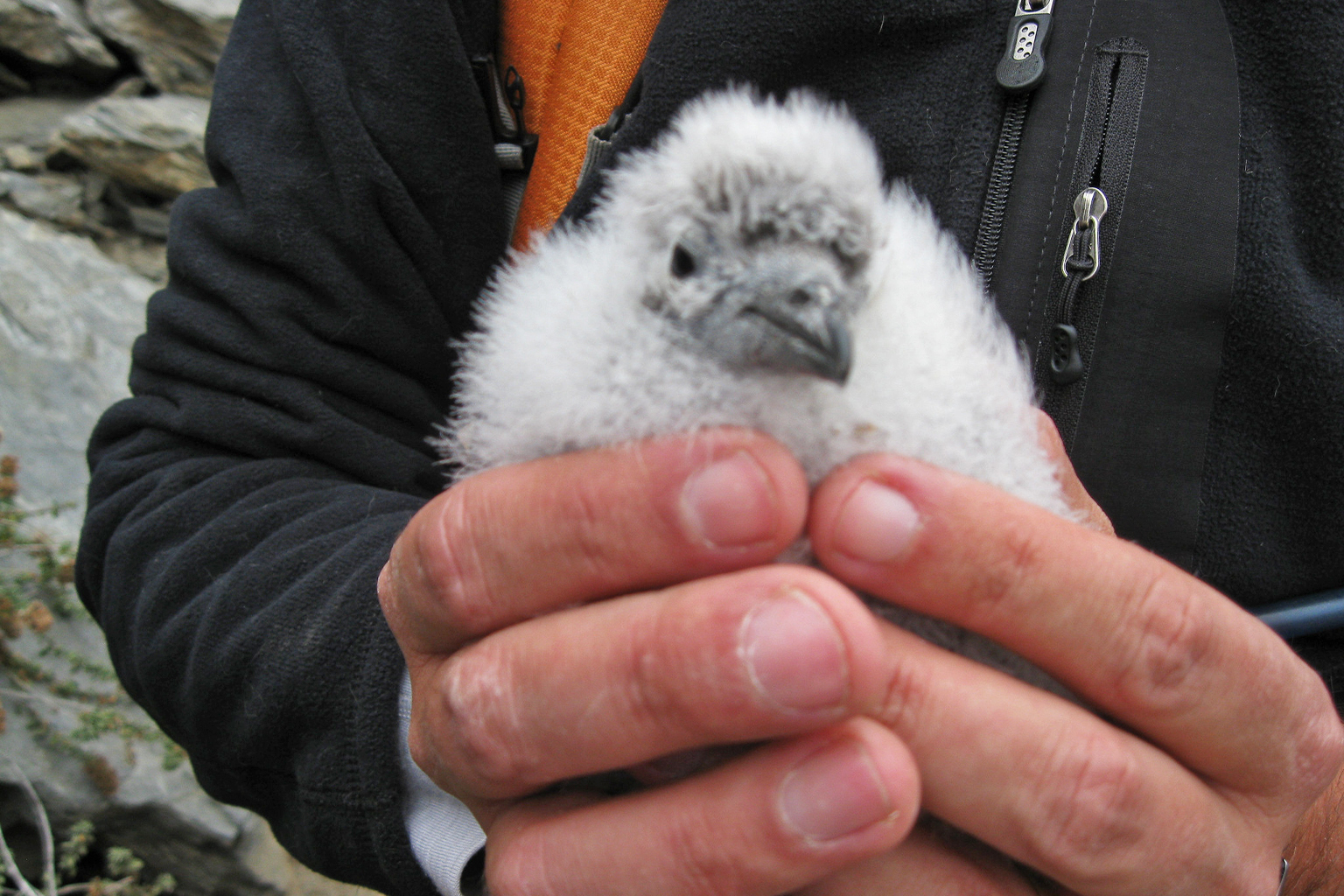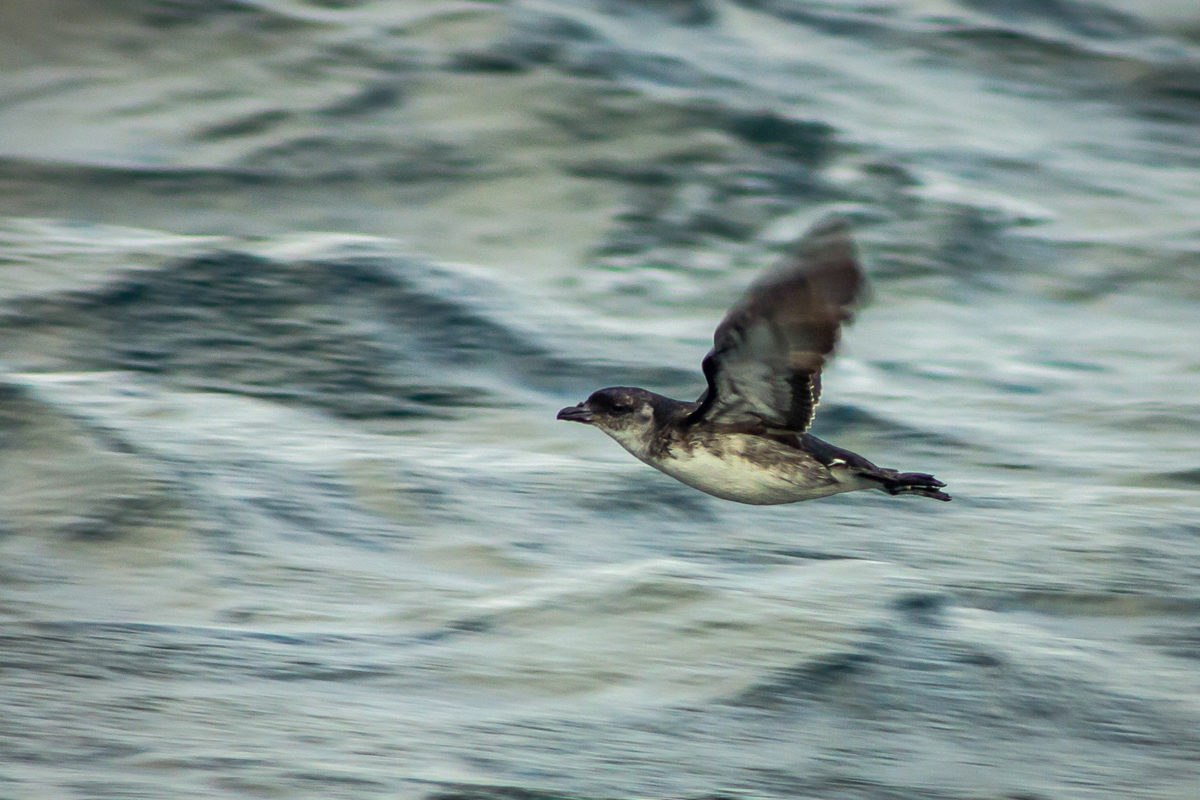- Chañaral Island off the coast of Chile used to be a prime nesting site for the Peruvian diving petrel, but the species largely disappeared from the island after the introduction of invasive rabbits and foxes.
- In 2013, researchers and wildlife managers eradicated these invasive species from Chañaral, and in 2019, a team began to lure the diving petrels back to the island by creating artificial nests and playing petrel calls.
- These efforts paid off: in November 2022, a Peruvian diving petrel chick hatched in a naturally dug burrow, generating optimism for the species’ future on the island.
The Peruvian diving petrel is a tiny, thrush-sized seabird that spends more time in the water than in the air. True to its name, it plunges into the chilly waters off the western coast of South America, to depths of up to 82 meters (270 feet) in search of fish, squid and krill, storing its catch in an expandable throat pouch. But this ocean-dwelling species is now at risk due to climate change and other human-driven pressures.
One threat to the Peruvian diving petrel (Pelecanoides garnotii), or yuncos, as they’re locally known, is habitat destruction and predation by invasive species. On Chile’s Chañaral Island, for instance, which used to be a prime nesting site for the species, rabbits and foxes have largely driven out the species. People introduced rabbits to Chañaral Island in the early 20th century to give stranded fishermen a food source, but the rabbits quickly took over the birds’ burrows and decimated the island’s vegetation. Then foxes were introduced to control the rabbits, but they seemed more interested in preying upon the diving petrels.
In 2013, researchers and wildlife managers at Island Conservation and the Chilean National Forestry Corporation (CONAF by its Spanish acronym) began restoring the Humboldt Penguin National Reserve, a nature reserve that encompasses three Chilean islands — Chañaral, Damas and Choros — by working to remove invasive species. In 2017, the Chañaral was declared rabbit- and fox-free.
Then, in 2019, a team from Island Conservation, CONAF, Catholic University of the North, and Project Puffin began to lure the Peruvian diving petrels back to Chañaral Island with social attraction methods — a strategy commonly used by experts to entice threatened seabirds to restore or establish new nesting grounds.

“We used artificial PVC nests and two sets of solar-powered speakers that play petrel calls to attract nearby adults to nest on the island,” Cristian Rivera, a park ranger at Chañaral Island, said in a statement. “This was one of the first projects of its kind on any Chilean island. Only a few days after the two sound systems were installed, petrels began arriving on the island to explore the surroundings.”
A year and a half after the project’s start, the team started finding burrows dug by the diving petrels. And then in November 2022, about three years after the project’s start, they found a downy chick in one of the burrows — the first known chick to hatch on the island in 40 years.
Maria Jose Vilches, an island restoration specialist at Island Conservation, said she and her colleagues didn’t expect chicks to reappear on the island for at least five years after the start of the social attraction project. “It was a surprise indeed,” she told Mongabay in an emailed statement.
The chick appears to be in good health, and should leave its nest later this month to make its trip into the ocean, she added.
A study published in Scientific Reports found that efforts to restore islands by driving out invasive species have been highly successful at reinstating native wildlife and ecosystems. A recent opinion piece also recognized that invasive species removal is a key way to restore connectivity between islands and oceans, generating benefits for both terrestrial and marine ecosystems.
“We have seen incredible recovery of seabirds on other islands freed of invasive mammals and signs are looking good that Chañaral will be the same,” Vilches said.

In addition to Chañaral Island, conservation experts have also removed invasive species from nearby Choros Island, which is currently the primary nesting ground of the Peruvian diving petrel. Vilches said she expects the colony on Choros will “sponsor” new juvenile colonies on Chañaral, especially since the islands are only a few kilometers apart.
“We are optimistic about the growth of this important Peruvian Diving-petrel colony,” Vilches wrote. “With the island free of invasive mammals, the island is now a safe place for them to nest. We will continue monitoring and to use social attraction tools to encourage more seabirds to nest on the island.”
Banner image: The Peruvian diving petrel is a tiny, thrush-sized seabird that spends more time in the water than in the air. Image by Daniel Teran / Island Conservation.
Elizabeth Claire Alberts is a senior staff writer for Mongabay. Follow her on Twitter @ECAlberts.
Avian flu hits Peru, killing thousands of sea birds and infecting some marine mammals
Citations:
Sandin, S. A., Becker, P. A., Becker, C., Brown, K., Erazo, N. G., Figuerola, C., … Zgliczynski, B. J. (2022). Harnessing island-ocean connections to maximize marine benefits of island conservation. Proceedings of the National Academy of Sciences, 119(51). doi:10.1073/pnas.2122354119
Spatz, D. R., Holmes, N. D., Will, D. J., Hein, S., Carter, Z. T., Fewster, R. M., … Russell, J. C. (2022). The global contribution of invasive vertebrate eradication as a key island restoration tool. Scientific Reports, 12(1). doi:10.1038/s41598-022-14982-5
